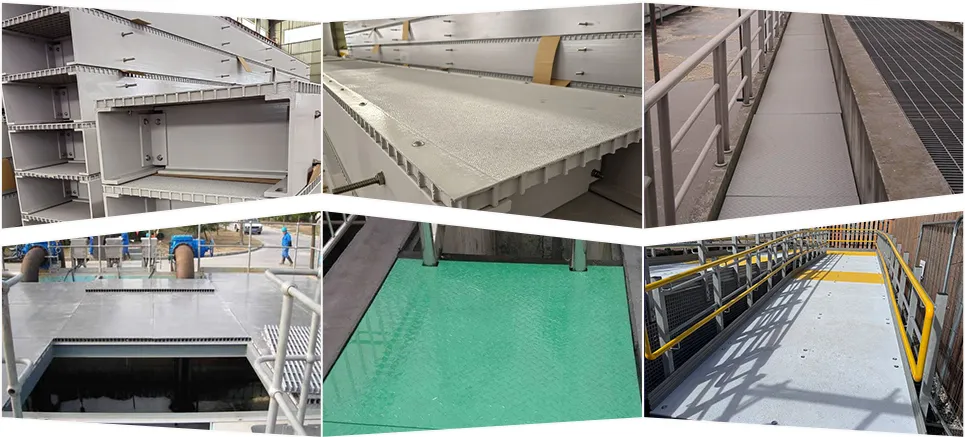loading...
- No. 9, Xingyuan South Street, Dongwaihuan Road, Zaoqiang County, Hengshui, Hebei, China
- admin@zjcomposites.com
- +86 15097380338
- Welcome to visit our website!
frp grating panels
Exploring the Benefits and Applications of FRP Grating Panels
Fiberglass reinforced plastic (FRP) grating panels have become increasingly popular across various industries due to their unique properties and numerous advantages. Made from a composite material of fiberglass strands and resin, FRP grating offers strength, durability, and lightweight characteristics that make it an ideal choice for a wide range of applications. In this article, we will explore the properties, advantages, and diverse applications of FRP grating panels.
Properties of FRP Grating Panels
FRP grating panels are engineered to provide high performance under demanding conditions. One of the key properties is their strength-to-weight ratio. FRP grating is significantly lighter than traditional steel grating, making it easier to handle and install. Despite its lightweight nature, FRP grating can support heavy loads, making it suitable for various industrial applications.
Another notable property is corrosion resistance. Unlike metal grating that can succumb to rust and degradation when exposed to harsh environments, FRP grating panels are impervious to chemicals, moisture, and UV rays. This corrosion resistance extends the lifespan of the panels, reducing maintenance costs and downtime for facilities that utilize them.
Additionally, FRP grating panels are non-conductive and non-magnetic, making them ideal for electrical applications and environments where safety is paramount. The slip-resistant surface of FRP grating also contributes to workplace safety, reducing the risk of slips and falls in high-footfall areas.
Advantages of FRP Grating Panels
The advantages of FRP grating panels are manifold. First and foremost, their installation process is straightforward and efficient. Lightweight and easy to cut, they can be quickly customized to fit specific dimensions, which can significantly reduce labor costs and installation time.
Moreover, FRP grating panels are an environmentally friendly option. Made from recyclable materials, they contribute to sustainability efforts in various sectors. Their long-lasting nature means fewer resources are used for replacements, further diminishing their environmental impact.
frp grating panels

Cost-effectiveness is another major advantage. Although the initial investment in FRP grating panels may be higher than that for traditional materials, the long-term savings in maintenance, replacement, and labor costs often outweigh the upfront expenditure.
Applications of FRP Grating Panels
FRP grating panels are versatile and can be employed in a plethora of applications. In the industrial sector, they are commonly used in chemical processing plants, manufacturing facilities, and wastewater treatment plants due to their chemical resistance and strength.
In the construction industry, FRP grating is utilized for walkways, platforms, and stair treads, providing a safe and durable solution for both indoor and outdoor environments. The lightweight nature of FRP products can also result in significant savings in structural support costs.
Another noteworthy application is in the marine industry. FRP grating's corrosion resistance makes it a suitable choice for docks, piers, and other marine environments where exposure to saltwater and harsh weather conditions is prevalent.
Additionally, FRP grating is increasingly being used in public spaces such as parks and recreational areas. Its slip-resistant surface and maintenance-free nature make it an attractive option for pathways, bridges, and viewing platforms.
Conclusion
In summary, FRP grating panels represent a robust and versatile solution in various industries. Their unique properties, including lightweight strength, corrosion resistance, and slip resistance, make them a preferred choice for many applications. As industries continue to seek safer, cost-effective, and environmentally friendly solutions, the demand for FRP grating panels is likely to grow. Whether it's in industrial settings, construction projects, marine environments, or public spaces, FRP grating offers a practical and efficient answer to modern engineering challenges.
-
Premium FRP Handrail for All ApplicationsNewsAug.29,2025
-
Low Maintenance FRP Mini Mesh Grating ProductsNewsAug.29,2025
-
Innovative FRP Square Tubes for Modern Industrial SolutionsNewsAug.29,2025
-
FRP Water Storage Tanks Wholesale Solutions for Bulk BuyersNewsAug.29,2025
-
FRP Molded Grating Solutions for Diverse Industrial ApplicationsNewsAug.29,2025
-
Construction Advancements Through FRP Pultruded ProfilesNewsAug.29,2025
-
Why Choose FRP Railings, Guardrails, and Handrail Systems?NewsAug.29,2025
